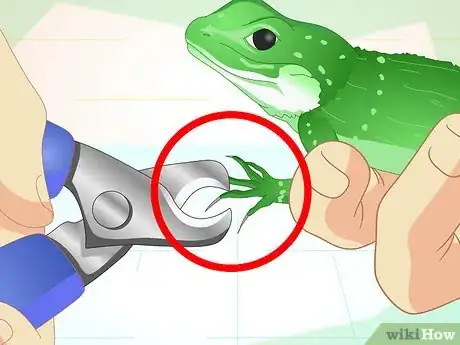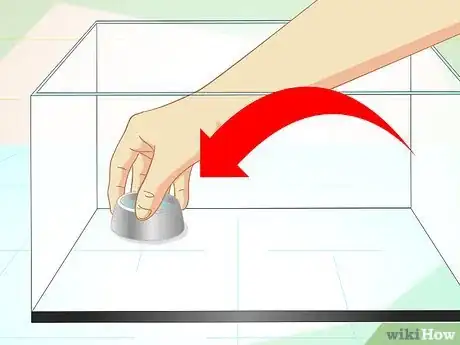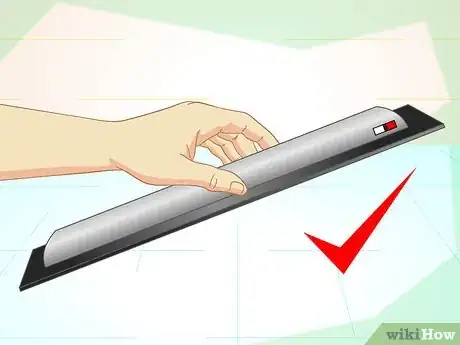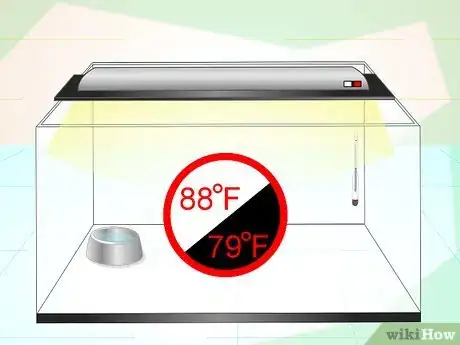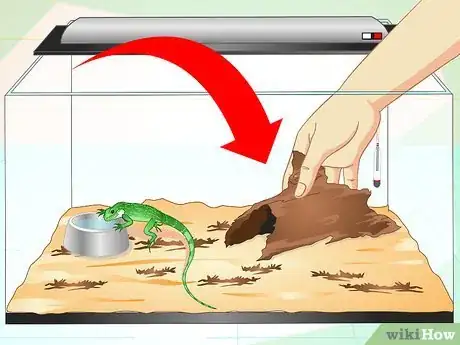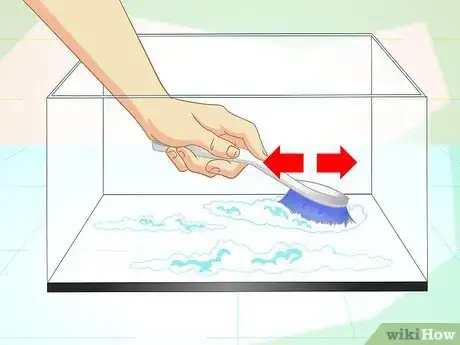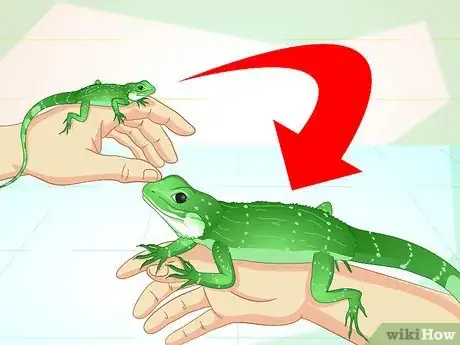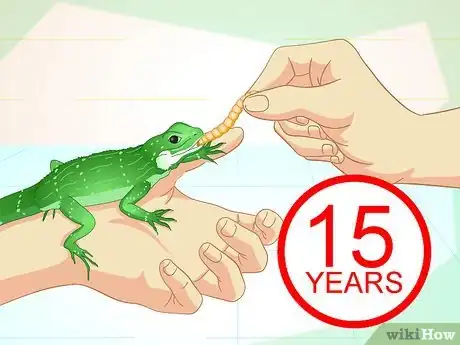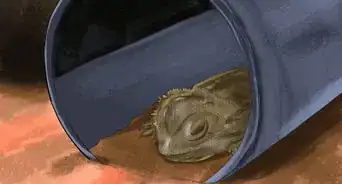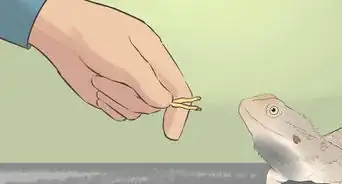This article was co-authored by Pippa Elliott, MRCVS. Dr. Elliott, BVMS, MRCVS is a veterinarian with over 30 years of experience in veterinary surgery and companion animal practice. She graduated from the University of Glasgow in 1987 with a degree in veterinary medicine and surgery. She has worked at the same animal clinic in her hometown for over 20 years.
wikiHow marks an article as reader-approved once it receives enough positive feedback. In this case, 86% of readers who voted found the article helpful, earning it our reader-approved status.
This article has been viewed 84,060 times.
Chinese water dragons can make great pets. However, you should be prepared to properly care for them. Like all reptiles, they require careful attention, need specialized diets, controlled temperatures in their enclosure, and gentle handling. If you feel like you would be a good match for a Chinese water dragon, learn some more details on what it takes to care for them.
Steps
Caring for Your Water Dragon
-
1Learn how to handle your water dragon. Part of the fun of having a pet is handling it and enjoying its company. Handling your water dragon can be fun for both you and your pet, if done properly. As always, be gentle whenever handling your dragon, in addition to these other steps:[1]
- Handle your dragon at a young age to ensure that it's accepting of being handled as an adult.
- Work slowly when trying to handle your water dragon at first. It will need to get used to your presence before trusting you.
- Don't force any interaction with your water dragon. Doing so will only cause your water dragon to distrust you.
- Try hand feeding your dragon first, inside the cage. Once it accepts food from your hand, you can try to remove it from its container.
- Never pick up a water dragon by its tail.
-
2Provide a proper diet. Your water dragon will need a diet that suits its nutritional needs and matches what it would eat in the wild. The diet will consist mainly of insects, of various types, and some vegetables and fruit. This diet will help keep it healthy, strong, and happy.[2]
- The main elements of the diet include crickets and mealworms. However, these tend to be low in calcium in captivity and need to be dusted with calcium powder immediately prior to feeding to the water dragon, to ensure that the dragon gets enough calcium in the diet for healthy bones.
- Waxworms are also an option, however, they are high in fat and should be offered sparsely.
- Dark green vegetables, such as kale, collard, mustard, and dandelion leaves can be a great addition to your dragon's diet.
- Some fruits can be included as well. Try feeding your water dragon bananas, cantaloupe, or strawberries.
- Large adult water dragons can eat earthworms, pinkie mice, or small feeder fish.
- Young dragons should be fed daily.
- Adult water dragons should be fed once every three days.
Advertisement -
3Groom your water dragon. Your water dragon won't require much grooming, however, there are some things you can do to keep your water dragon clean and happy. The two main areas of grooming that you will focus on involve the nails and bathing of your dragon.[3]
- Keep an eye on your water dragons nails. If you notice the nails getting long, they can be trimmed. Keeping them short will make handling the dragon more comfortable.
- Find someone who can show you how to trim your dragons nails in person, as it is difficult for a beginner to do without seriously harming the water dragon.
- Allow your water dragon to soak in water regularly. This can help prevent constipation as well as keep it clean.
-
4Schedule regular exams with a veterinarian. As with all pets, scheduling a regular exam with your veterinarian is a critical part of maintaining that pet's health. Find a local veterinarian that works with reptiles and ask them about setting up appointments to examine your Chinese water dragon.[4]
- Young dragons, under the age of four, should be checked at least once annually.
- Older water dragons, over four years, should be examined twice yearly.
Housing Your Water Dragon
-
1Maintain water and humidity levels. Water dragons need adequate levels of both standing water and humidity in its environment. Both water and humidity levels must be maintained properly to ensure the longevity and health of your water dragon.[5] [6]
- Humidity should be kept at around 80% in the water dragon's container. You can find a device to measure humidity levels at any pet store.[7]
- Drip machines are available to maintain humidity. Spray bottles and waterfalls will work as well.
- Water should be made available in large containers. These containers should allow your water dragon easy access. Make sure that your dragon can get out of the water containers when it wants, without trouble.
-
2Purchase proper lighting. Providing the right amount and type of lighting is important to help keep your water dragon in a good state of health and well-being. Like other reptiles, water dragons are cold blooded, and need external heat to regulate its body temperature. Water dragons are also diurnal, and need light to know if it is night or daytime.[8]
- For the main, daytime lighting, use incandescent lighting. These will provide white light as well as heat.
- Lights in the enclosure should be turned off at night. Make sure however, that the temperature is maintained at around 75-79°F.
- Water dragons need exposure to ultraviolet light. During the day, the sun will provide this, however, UV light cannot penetrate glass. Place your water dragons in a secure mesh container to allow the UV light to reach it.
- Never place a glass container in direct sunlight as this may cause deadly temperatures.
- There are specialized black lights that emit the necessary band of UV light. These black lights are not the typical black light, instead, they are found in stores that specialize in reptile care. Make sure the reptile can stand withing 8 - 10 inches of the lamp in order to benefit from the UV as it doesn't transmit much further than this and the beneficial levels drop off. Change the UV bulb every 6 months as the UV emission degrades after this time.
-
3Create the right temperature. Lights in the cage will be the main source of heat in the enclosure, but you may add additional, more area specific, heating implements. Keeping the temperature in the cage regulated is critical to maintaining the health of your water dragon.[9] [10]
- Temperatures in the cage, during the day, should be kept at around 84-88°F. Night temperatures should be lowered down to 75-79°F
- You should also provide a secondary heating source, such as a well secured basking light. The temperature under the light should reach around 90-95°F.
-
4Place a good substrate in the enclosure. You will need some organic material to cover the bottom of your water dragons enclosure. Water dragons need a specific kind of substrate that best mimics its natural environment.[11] [12]
- Ideally, you will want a substrate that is affordable and easily cleaned or replaced.
- Newspaper or Astroturf are common substrates.
- A mixture of sand and peat is also recommended, although difficult to clean. If you do use sand, purchase special fine grade sand marked as safe for reptile use on the packaging. Otherwise, if ingested, it can cause serious bowl blockages.
- Avoid cedar shavings, wood shavings, gravel, potting soil, or cat litter if they contain vermiculite, pesticides, or fertilizer.
-
5Get a big enough container. The size of your water dragon's enclosure will need to be big enough to allow your water dragon to move and live in comfortably. A cage that is too small may present a health hazard for your water dragon.[13]
- Generally, the enclosure should be as high as it is long. The width should be half the hight.
- Water dragons can grow to a large size. For an adult water dragon you will need to have a cage of around 6' long, 6' tall, and 3' wide.
-
6Add some decorations. You will want to keep your water dragons enclosure an interesting and safe place. In the wild, water dragons want to climb and explore. Recreating the natural environment will allow your water dragon to feel comfortable in its new home.[14]
- Provide branches for your water dragon to climb on. Avoid any wood types that are sticky or exude sap.
- Give your water dragon a safe place to hide. This can be as simple as a cardboard box. Provide many hiding spots in the enclosure.
- Place plants within the water dragons environment. Make sure the plants are non-toxic to your water dragon, such as hibiscus or staghorn ferns.
- Be aware of the soil that the plants are grown in as well, avoiding any that contain vermiculite, pesticides, or fertilizer.
-
7Keep up with cleaning the cage. As with any animal kept in captivity, cleaning the enclosure and maintaining proper hygiene will help keep both you and your pet in good health. Keeping a good schedule when it comes to cleaning the cage will make it easier to remember this important task.[15]
- Always wear gloves when cleaning the cage.
- Remove feces, skin sheds, leftover food, and water spills daily.
- Clean food and water bowls daily.
- An entire cage cleaning should be done weekly.
- Rocks should be cleaned and boiled for around thirty minutes.
- Branches should cleaned and then heated in an oven at 200°F for around 30 minutes.
Learning About Water Dragons
-
1Understand that water dragons can get big. Water dragons can grow quite large, and you should feel comfortable handling a large lizard. You will also need the right amount of space to dedicate to an enclosure that will comfortably house your new water dragon.[16]
- Adult males will grow to about 3 feet in length.
- Adult females will reach around 2 feet in length.
-
2Realize that a water dragon is a long term commitment. Water dragons can live up to fifteen years in captivity. Caring for a water dragon is a commitment that you should be prepared for. Do not acquire a water dragon if you do not feel like you can commit this amount of time to caring for one.[17]
-
3Read over some common health issues. If well cared for, your water dragon should enjoy a long and healthy life. However, you should be observant for any health issues that may arise over the course of your water dragon's life. Visit with your veterinarian regularly to catch some of the more common health issues with water dragons.[18]
- Lack of calcium or underexposure to UV light can cause metabolic bone disease. This will have the symptom of weakness in the legs or jaw.
- Your water dragon may cause abrasions to its own face by bumping into the walls of the enclosure.
- Overfeeding will cause obesity in your water dragon.
- Injuries or other illnesses may occur at any time. Always monitor your water dragons behaviour to alert you to possible health issues.
References
- ↑ http://www.peteducation.com/article.cfm?c=17+1796&aid=3128
- ↑ http://www.peteducation.com/article.cfm?c=17+1796&aid=3128
- ↑ http://www.peteducation.com/article.cfm?c=17+1796&aid=3128
- ↑ http://azeah.com/lizards/basic-care-water-dragon
- ↑ http://www.peteducation.com/article.cfm?c=17+1796&aid=3128
- ↑ http://www.thereptilian.co.uk/care_sheets/chinese_water_dragon_physignathus_cocincinus_care_sheet.htm
- ↑ http://azeah.com/lizards/basic-care-water-dragon
- ↑ http://www.thereptilian.co.uk/care_sheets/chinese_water_dragon_physignathus_cocincinus_care_sheet.htm
- ↑ http://www.peteducation.com/article.cfm?c=17+1796&aid=3128
- ↑ http://www.thereptilian.co.uk/care_sheets/chinese_water_dragon_physignathus_cocincinus_care_sheet.htm
- ↑ http://www.thereptilian.co.uk/care_sheets/chinese_water_dragon_physignathus_cocincinus_care_sheet.htm
- ↑ http://www.peteducation.com/article.cfm?c=17+1796&aid=3128
- ↑ http://www.peteducation.com/article.cfm?c=17+1796&aid=3128
- ↑ http://www.thereptilian.co.uk/care_sheets/chinese_water_dragon_physignathus_cocincinus_care_sheet.htm
- ↑ http://www.peteducation.com/article.cfm?c=17+1796&aid=2847
- ↑ http://www.thereptilian.co.uk/care_sheets/chinese_water_dragon_physignathus_cocincinus_care_sheet.htm
- ↑ http://www.thereptilian.co.uk/care_sheets/chinese_water_dragon_physignathus_cocincinus_care_sheet.htm
- ↑ http://www.peteducation.com/article.cfm?c=17+1796&aid=3128
About This Article
To take care of a Chinese water dragon, work up to handling it gradually, since it will need to get used to your presence before developing trust. Next, provide a healthy diet of crickets and mealworms supplemented with dark green vegetables like kale and mustard. It's also important to trim its nails regularly and provide a small dish of fresh water daily for your pet to soak in. For more tips from our Veterinary co-author, like how to maintain your Chinese water dragon's habitat, read on!


